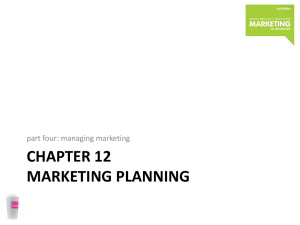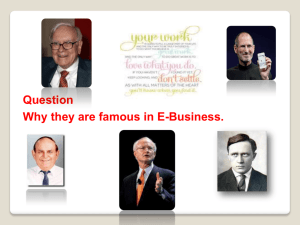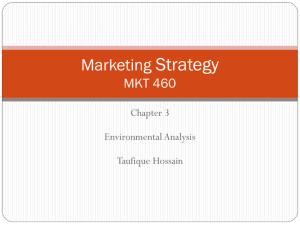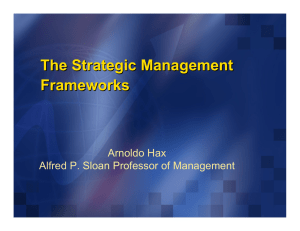Strategic Management Frameworks: Porter, RBV, Delta Model
advertisement
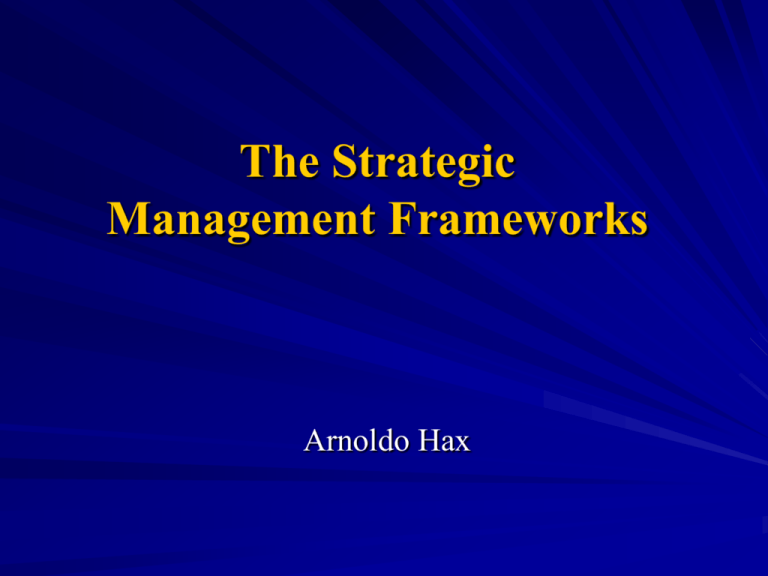
The Strategic Management Frameworks Arnoldo Hax The Frameworks for Competitive Positioning • Porter • Resource-Based View of the Firm • The Delta Model Porter’s Framework: Explaining the Profitability of a Business Competitive Positioning Industry Structure Achieving sustainable competitive advantage Factors affecting industry profitability Strategy Formulation and Implementation Defining and executing the managerial tasks Figure 5-1. Elements of Industry Structure: Porter’s Five- Forces Barriers to Entry Economics of scale Product differentiation Brand identification Switching cost Access to distribution channels Capital requirements Access to latest technology Experience and learning effects Government action Industry protection Industry regulation Consistency of policies Capital movements among countries Custom Duties Foreign exchange Foreign ownership Assistance provided to competitors Threat of New Entrants Suppliers New Entrants Rivalry among Competitors Concentration and balance among competitors Industry growth Fixed (or storage) cost Product differentiation Intermittent capacity increasing Switching costs Corporate strategic stakes Barriers to Exit Asset specialization One-time cost of exit Strategic interrelationships with other businesses Emotional barriers Government and social restrictions Industry Competitors Bargaining Power of Suppliers Bargaining Power of Buyers Intensity of Rivalry Threat of Substitutes Power of Suppliers Number of important suppliers Availability of substitutes for the suppliers products Differentiation or switching cost of suppliers products Suppliers threat of forward integration Industry threat of backward integration Suppliers contribution to quality or service of the industry products Total industry cost contributed by suppliers Importance of the industry to suppliers profit Substitutes Availability of Substitutes Availability of close substitutes User’s switching costs Substitute producer’s profitability and aggressiveness Substitute price-value Buyers Power of Buyers Number of important buyers Availability of substitutes for the industry products Buyers’ switching costs Buyers threat of backward integration Industry threat of forward integration Contribution to quality or service of buyers products Total buyers cost contributed by the industry Buyers profitability Make a business in an attractive industry where you can excel; then excel by achieving a low cost of differentiation through unique activities The Value Chain Source: This setup for the value chain was suggested by Michael E. Porter (1985). Merck’s Value Chain There are two ways to compete: Low Cost or Differentiation The efficiency of the low cost provider’s cost structure allows pricing below the average competitor, which in the long run may put average competitors out of business. This is why the alternative to low cost needs to be differentiation, offering unique product attributes that the customer values and will pay a premium for. However, the Total Customer Solutions positioning offers a possible preferred alternative by introducing significant cost savings (and/or revenue increases) to the customer Critical Elements in Porter’s Frameworks Focus of Strategic Attention Types of Competitive Advantage Porter Industry/ Business Low Cost or Differentiation Basic Unit of Competitive Advantage Activities Porter’s Winning Formula Pick a business in an attractive industry in which you can excel. Notice that Porter’s Framework stressed rivalry and competition. Therefore, an attractive industry is one in which we can achieve as close to a monopolistic position as possible. In turn, the message of the value chain is to achieve sustainable advantage by beating your competitors, if not in all, at least in those activities that are most crucial to competition. Strategy is War! The Resource-Based View of the Firm Framework Resources can be classified into three broad categories • Tangible assets are the easiest to value, and often are the only resources that appear on a firm’s balance sheet. They include real estate, production facilities, and raw materials, among others. Although tangible resources may be essential to a firm’s strategy, due to their standard nature, they rarely are a source of competitive advantage. There are, of course, notable exceptions. Resources can be classified into three broad categories (continued) • Intangible assets include such things as company reputations, brand names, cultures, technological knowledge, patents and trademarks, and accumulated learning and experience. These assets often lay an important role in competitive advantage (or disadvantage), and firm value. Resources can be classified into three broad categories (continued) • Organizational capabilities are not factor inputs like tangible and intangible assets; they are complex combinations of assets people, and processes that organizations use to transform inputs into outputs. The list of organizational capabilities includes a set of abilities describing efficiency and effectiveness: low cost structure, “lean” manufacturing, high quality production, fast product development. Source: David Collis and Cynthia Montgomery A Resource-Based Approach to Strategy Analysis: A Practical Framework Source: Robert M. Grant The Resource-Based View: Elements of Competitive Advantage Source: Adapted from Peteraf (1993) and Ghemawat (1991). The Resource-Based View of the Firm Winning Formula Develop resources and capabilities which are rare, valuable non-tradeable, that form the basis of the core competencies of the firm; make those resulting advantage sustainable by precluding imitation or substitution from competitors; appropriate the resulting economic rent by preventing negative hold-up and slack conditions; and make sure that the implementation process is done in such a way that its associated costs do not upset the resulting benefits. It is Strategy by Real Estate! Comparison of Critical Elements in Porter’s and Resource-Based View Frameworks Porter Resource-Based View Focus of Strategic Attention Industry/Business Corporation Types of Competitive Advantage Low cost or Differentiation Resources, Capabilities Core Competencies Basic Unit of Competitive Activities Core Products, Advantage Strategic Architecture Comparison Among Strategy Frameworks Porter’s Five Forces Model The Delta Model- An Integrative Strategic Framework 1. Create a powerful 10x force to change the rules of the game. Reject initiation of competitors, a product-centric mentality, and a commoditization mindset. 2. Generate significant barriers around the customers through a unique customer value proposition based on deep customer segmentation, and consumer understanding. 3. Do not use competitors as a central benchmark to guide your strategic actions. The key industries to concentrate on are those of your customers, suppliers, and complementors. Strategy is not war with your competitors; it is love with your customers, suppliers, consumers, and complementors. 4. Develop and nurture the integrated value chain with your key suppliers and customer. Bring in all the power of B2B and B2C to accomplish this objective. This is critical for customer lock-in. 5. Add a new player: the complementors. Seek complementor support and investment in your business. Make them key partners in seeking the delivery of Total Customer Solutions. Extend the unique value proposition to include complementors, as well as suppliers. This is the key for obtaining complementor lock-in, competitor lock-out, and ultimately System Lock-In. 6. If your customer, suppliers, and complementors are numerous and fragmented you could also provide them with stateoftheart management practices and a wealth of information and intelligence that they could never acquire otherwise. Your lock-in will be admirably enhanced. The Required Resources and Capabilities for the Delta Model 1. First and foremost, you need a deep customer and consumer understanding obtained via a detailed segmentation and supported by aggregated and granular metrics. 2. This understanding should also be extended to critical suppliers and complementors. Do not get trapped in your industry trends alone. 3. The implementation of the new business model is realizable mostly because the opportunities and potentials offered by the Internet and its associated technologies: e-business, ecommerce, e-systems. The appropriation of this skill is essential. The Required Resources and Capabilities for the Delta Model (Continued) 4. Create the dynamic and entrepreneurial environment of risk-taking and reward-sharing originated by the professional challenges associated with the “new technologies.” 5. The ultimate output is the development and implementation of unique and exciting value propositions for all the key players: customers, consumers, suppliers, and complementors. The first mover advantage is overwhelming. You have to be fast.
